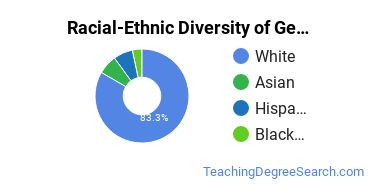General Education at Gratz College
If you plan to study general education, take a look at what Gratz College has to offer and decide if the program is a good match for you. Get started with the following essential facts.Gratz College is located in Melrose Park, Pennsylvania and approximately 454 students attend the school each year.
Want to know more about the career opportunities in this field? Check out the Careers in General Education section at the bottom of this page.
Gratz College General Education Degrees Available
- Master’s Degree in Education
Gratz College General Education Rankings
Education Student Demographics at Gratz College
Take a look at the following statistics related to the make-up of the education majors at Gratz College.
Gratz College General Education Master’s Program

Of the students who received a education master's degree from Gratz College, 93% were white. This is above average for this degree on the natiowide level.
The following table and chart show the race/ethnicity for students who recently graduated from Gratz College with a master's in education.

| Race/Ethnicity | Number of Students |
|---|---|
| Asian | 0 |
| Black or African American | 0 |
| Hispanic or Latino | 1 |
| White | 39 |
| International Students | 0 |
| Other Races/Ethnicities | 2 |
Concentrations Within General Education
The following education concentations are available at Gratz College. The table shows all degrees awarded in this field awarded for all degree levels at Gratz College. A concentration may not be available for your level.
| Concentration | Annual Degrees Awarded |
|---|---|
| General Education | 39 |
Related Majors
Careers That Education Grads May Go Into
A degree in education can lead to the following careers. Since job numbers and average salaries can vary by geographic location, we have only included the numbers for PA, the home state for Gratz College.
| Occupation | Jobs in PA | Average Salary in PA |
|---|---|---|
| Education Professors | 2,690 | $70,990 |
References
*The racial-ethnic minorities count is calculated by taking the total number of students and subtracting white students, international students, and students whose race/ethnicity was unknown. This number is then divided by the total number of students at the school to obtain the racial-ethnic minorities percentage.
- College Factual
- National Center for Education Statistics
- O*NET Online
- Image Credit: By Shuvaev under License
More about our data sources and methodologies.
